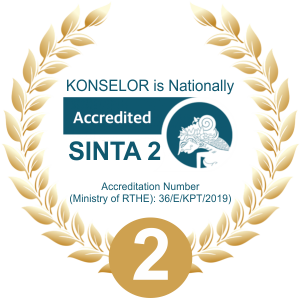Implementing group counseling action research to improve students learning motivation
 ), Kadek Suranata(2), I Komang Ribek Teja Budiarta(3), Kadek Suranata(4),
), Kadek Suranata(2), I Komang Ribek Teja Budiarta(3), Kadek Suranata(4), (1) Universitas Pendidikan Ganesha
(2) Universitas Pendidikan Ganesha
(3) Universitas Pendidikan Ganesha
(4) Universitas Pendidikan Ganesha
 Corresponding Author
Corresponding Author
Copyright (c) 2018 Kadek Suranata
DOI : https://doi.org/10.24036/0201874102528-0-00
Full Text:
 Language : id
Language : id
Abstract
Keywords
References
Ardi, Z., Ibrahim, Y., & Said, A. (2012). Capaian Tugas Perkembangan Sosial Siswa dengan Kelompok Teman Sebaya dan Implikasinya terhadap Program Pelayanan Bimbingan dan Konseling. Konselor, 1(2).
Berg, R. C., Landreth, G. L., & Fall, K. A. (2006). Group Counseling.
Brigman, G., & Campbell, C. (2003). Helping students improve academic achievement and school success behavior. Ssional School Counseling, 91–98.
Cutuli, J. J., Desjardins, C. D., Herbers, J. E., Long, J. D., Heistad, D., Chan, C.-K., … Masten, A. S. (2013). Academic achievement trajectories of homeless and highly mobile students: resilience in the context of chronic and acute risk. Child Development, 84(3), 841–57. https://doi.org/10.1111/cdev.12013
Gürgan, U. (2013). The effect of psychological counselling in group on life orientation and loneliness levels of the university students. Educational Research and Reviews, 8(24), 2303-2312.
Karti Soeharto, dkk. 2003. Learning Technology (Systems Approach, Conceptionand Model, SAP, Evaluation, Media Learning Resources).Surabaya: Surabaya Intelectual Club.
Kementerian Pendidikan dan Kebudayaan. (2016). Panduan Operasional Penyelenggaraan Bimbingan dan Konseling Sekolah Menengah Kejuruan (SMK), 169.
Kementerian Pendidikan Nasional. (2014). Peraturan Menteri Pendidikan Nasional No 111 Tahun 2014 Tentang Penyelenggaraan Bimbingan dan Konseling Pada Pendidikan Dasar dan Menengah.
Mitchell, K. R., & Kim, Ng, T. (1972). Effects of group counseling and behavior therapy on the academic achievement of test-anxious students. Journal of Counseling Psychology, 19(6), 491.
McClelland, D. C., & Burnham, D. H. (2008). Power is the great motivator. Harvard Business Review Press.
Plötner, M., Over, H., Carpenter, M., & Tomasello, M. (2016). What Is a Group? Young Children’s Perceptions of Different Types of Groups and Group Entitativity. PLOS ONE, 11(3), e0152001. doi:10.1371/journal.pone.0152001
Prayitno. 2004. Layanan Bimbingan Kelompok Konseling Kelompok. Padang : UNP.
Sari, E. P. (2013). Pengembangan Model Layanan Bimbingan Kelompok dengan Teknik Sosiodrama untuk Meningkatkan Sikap Prososial. Jurnal Bimbingan Konseling, 2(2).
Schunk, D. H. (2004).Learning theories: An educational perspective (4th ed.). Upper Saddle River, NJ: Prentice-Hall.
Shafie, A. A. H. B., Miskam, N. A. B. A., Rozubi, N. B. C., & Anuar, A. A. B. (2018). Enhancing the Self-Efficacy and Assertiveness Level Among the Bullied Victim School Students By Using Cognitive Behaviour Theraphy (CBT) in Group Counselling Approach. International Journal of Academic Research in Business and Social Sciences, 8(1), 300-313.
Suranata, K. (2010). Layanan bimbingan kelompok untuk meningkatkan sikap antisipatif siswa terhadap bahaya penyalahgunaan napza (Studi Eksperimen Terhadap Siswa Kelas X SMA Lab. Undiksha). Jurnal IKA, 8(1).
Suranata, K. (2013). Peningkatan Kompetensi Guru BK dan Kualitas Pelayanan Bimbingan Konseling Melalui Pelatihan dan Pendampingan Kaji Tindak Layanan Konseling di SMA dan SMK Singaraja. Singaraja.
Suranata, K. (2014). Metode Praktik Lapangan Melalui Kaji Tindak Bimbingan Konseling Untuk meningkatkan Kemampuan Melakukan praktikum Konseling Kelompok Bagi Mahasiswa Semester VII Mahasiswa Jurusan BK FIP Undiksha. Singaraja.
Suranata, K. (2017). Panduan Memimpin Kelompok Dalam Konseling Kelompok. Singaraja: Undiksha Press.
Susiani, K., & Suranata, K. (2017). Implementasi Metode Sokratik Melalui Lesson Study Untuk Meningkatkan Keterampilan Berpikir Kritis Mahasiswa. Indonesian Journal of Educational Counseling, 1(1), 27–40.
Supriyadi, A. M., Dwikurnaningsih, Y., & Windrawanto, Y. (2012). Reducing Bullying Through Sequentially Planned Integrative Counseling for Children (SPICC) Group Counseling for K-5 Student of SD N Pasekan 03 Ambarawa. BE THE LEADING ENTITY IN EDUCATION, 162
 Article Metrics
Article Metrics
 Abstract Views : 1235 times
Abstract Views : 1235 times
 PDF Downloaded : 341 times
PDF Downloaded : 341 times
Refbacks
- There are currently no refbacks.
Copyright (c) 2018 Kadek Suranata

This work is licensed under a Creative Commons Attribution 4.0 International License.







